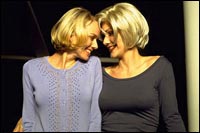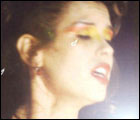| |
 |
|
|
For in a patriarchal culture, “Elle n’est
ni une ni deux (...) Elle résiste à toute définition adéquate.
Elle n’a d’ailleurs pas de de nom propre”. [“She is
neither one nor two (...) She resists all adequate definition.
Further, she has no proper name”] (35) Lynch’s woman equally
cannot be easily grasped. She does not cohere. Her character
is enigmatic and her language is often strange. For Irigaray,
woman desires differently : “Le désir de la femme
ne parlerait pas la même langue que celui de l’homme, et il
aurait été recouvert par la logique qui domine l’Occident
depuis les Grecs”. [“Woman’s desire would not be expected
to speak the same language as man’s ; woman’s desire
has undoubtedly been submerged by the logic that has dominated
the West since the time of the Greeks”] (36). In Irigaray’s
poetic polemics, the kind of strangeness and incoherence which
surrealism associates with women is positively transformed.
These qualities are given a genuine subjective power. Women
are released from a patriarchal order and discourse to powerfully
and wonderfully desire each other. It is a unique love.
 |
|
|
|
As we have seen, Lynch’s lesbian lover
is influenced by surreal and modern images and notions of
lesbian love. She is thus granted a sensual and transgressive
power. She is morally complex. We have also seen how he references,
plays with and transforms those concepts and images. Lynch’s
women are not merely exotic objects of a masculine, avant-garde
elite. Although Betty’s love is deformed and she is disputably
transformed into a phallic, murderous figure, the depiction
of lesbian love in Mulholland Drive may be interpreted
as a form of poetic resistance to a phallic, patriarchal order.
It exists a-temporally and flowers outside the space of Hollywood,
released from its masculine corruption and its capacity to
warp the feminine. The richly post-modern play of modernist,
surreal and Hollywood concepts and images unmask the artificiality
of the lesbian and expose the masculinist desire to control,
exploit and rupture the feminine. Love is authentic in Mulholland
whether tender or pathological. It is not fraudulent. The
sapphic heroines’ love breaks with artificiality. In the land
of artificiality, of artificial woman and artificial breasts,
the breast paradoxically signifies truth. Love in Mulholland
Drive is bathed in an luscious romanticism. The love
scenes in Mulholland Drive engender desire and melancholic
yearning. Like all great romances, the love story in Mulholland
Drive inhabits an autonomous, atemporal utopian space.
Love by its nature is absolute. Love exists despite Hollywood.
The most powerful romantic scene in Mulholland is when
Betty and Rita witness the crying woman’s Rebekah Del Rio’s
rendition of LLorando at the after hours club Silencio.
Exceeding the strange narrative of Mulholland, transcending
its time and space, the song captures Betty’s obsession for
Rita as a perfect embodiment of desire and melancholic yearning.
It is the apex of Betty and Rita’s love ; in IIorando,
love is absolute. Nevertheless, as has been noted, the llorana
is a figure of tragedy who anticipates tragedy. Great love
is always invariably doomed. Despite the voyeurism it provides
a heterosexual male audience, Mulholland’s lesbianism
signifies desire and love for one’s own. Poetically and erotically,
the women are perfect lovers. The pretty, gamine short-haired
blonde enraptured by the classic Latin beauty. Psychically
and sexually, the women provide each other and the audience
narcissistic female pleasure. In a traditionally male-dominated
Hollywood, the figure of the lesbian becomes a radical romantic
figure as she is sexually subversive and ruptures traditional
gender identifications. Lynch’s transgressive heroine is simultaneously
a figure of identification and desire for both men and women.
Ultimately, Mulholland Drive reminds us that films
are all about desire. This desire is often genuinely revolutionary.
|